Dagon (2001)
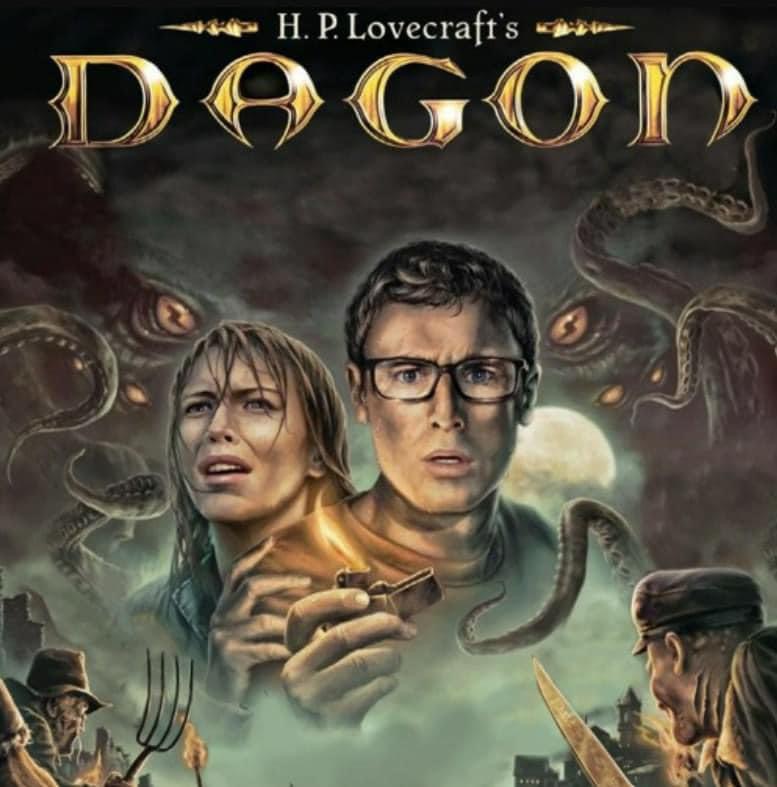
“Dagon” (2001), directed by Stuart Gordon, is a horror film based on the works of H.P. Lovecraft, specifically drawing elements from the short story Dagon and the novella The Shadow over Innsmouth. Known for his devotion to adapting Lovecraftian horror to the screen, Gordon, along with his frequent collaborator Dennis Paoli, sought to capture the mythos and unsettling dread characteristic of Lovecraft’s writing. The film’s execution blends elements of supernatural horror, body horror, and cosmic dread, creating a distinct atmosphere that pays homage to Lovecraft’s literary style while adding a modern cinematic touch.
Suggested videos for you:
Plot Overview
The film opens with Paul Marsh (Ezra Godden), a tech entrepreneur, enjoying a sailing vacation off the coast of Spain with his girlfriend Barbara (Raquel Meroño) and their friends. A sudden storm results in their boat crashing into rocks near a decrepit, fog-shrouded fishing village called Imboca. As Paul swims ashore to find help, he discovers that the town is inhabited by strange, menacing villagers with fish-like features and a disturbing air of secrecy.
As Paul delves deeper into the town’s mysteries, he learns that the inhabitants worship an ancient sea deity called Dagon and have made dark pacts to achieve wealth and prosperity. The cost of this prosperity, however, is revealed through disturbing rituals, human sacrifices, and the slow transformation of the townspeople into grotesque aquatic beings. Paul’s search for Barbara and attempts to escape Imboca uncover shocking truths about the village’s past and his own connection to the horror unfolding before him.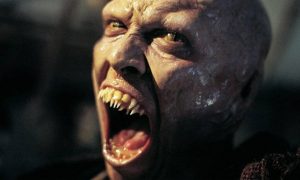
Themes and Symbolism
“Dagon” captures the quintessential themes of Lovecraftian horror, most notably the insignificance of humanity in the face of ancient, godlike beings and the terror of the unknown. The film’s titular deity, Dagon, represents not only an ancient power indifferent to human suffering but also a reflection of humankind’s tendency to make catastrophic sacrifices for material gain. The people of Imboca, once a normal fishing village, succumbed to the allure of Dagon’s promises and became trapped in a cycle of worship and corruption, highlighting themes of greed, religious fanaticism, and the consequences of forsaking humanity for power.
Transformation is another core theme, depicted both literally and figuratively. The townspeople’s grotesque physical metamorphosis into sea creatures symbolizes their moral and spiritual descent as they abandon their humanity to serve Dagon. The unsettling nature of this transformation embodies the Lovecraftian fear of losing one’s identity and succumbing to an inescapable fate. Paul’s journey mirrors this theme as he battles to retain his sanity and humanity in the face of the overwhelming supernatural forces surrounding him.
The notion of ancestral guilt and destiny is also prominent. As Paul uncovers his own connection to Imboca and Dagon, the film touches on the Lovecraftian idea that horror is not always external but can be ingrained in one’s bloodline and history. This element intensifies the story’s sense of fatalism and the inevitability of facing one’s origins.
Visual and Artistic Execution
Stuart Gordon’s direction effectively captures the eerie and decaying atmosphere of Imboca, which serves as a character in itself. The town’s crumbling buildings, narrow alleys, and perpetually rain-soaked environment create an oppressive setting that encapsulates Lovecraft’s descriptions of decayed, haunted towns. The cinematography by Carlos Suárez emphasizes the claustrophobic feel of the village, with shots that linger on the grotesque inhabitants and murky interiors. This visual style reinforces the film’s themes of entrapment and decay, drawing the audience into a world that is as unsettling as it is intriguing.
The makeup and special effects, while limited by the film’s budget, are commendable for their creativity. The practical effects used to portray the villagers’ transformations into amphibious hybrids are both grotesque and memorable. The film’s use of practical creature design, mixed with digital effects, showcases Gordon’s commitment to tangible, tactile horror, even if some of the CGI elements appear dated by today’s standards.
The film’s score, composed by Carles Cases, adds an eerie, haunting quality that complements the visuals. The music oscillates between foreboding silence and sudden, jarring notes, heightening the tension during key scenes. This helps to immerse the audience in the protagonist’s mounting terror as he navigates the perilous landscape of .
.
Performances
Ezra Godden’s performance as Paul Marsh is central to the film’s narrative. His portrayal of an everyman thrust into nightmarish circumstances effectively channels Lovecraft’s typical protagonist: a rational individual grappling with irrational, sanity-shattering events. Godden’s ability to convey Paul’s fear, confusion, and desperation keeps the viewer engaged, even as the plot becomes increasingly surreal.
Raquel Meroño as Barbara brings a sense of warmth and urgency to her role, though her character functions more as a catalyst for Paul’s journey than as a fully fleshed-out figure. Francisco Rabal’s portrayal of Ezequiel, the last truly human resident of Imboca and a tragic witness to its dark transformation, adds depth to the narrative. His character provides the crucial exposition needed to understand Imboca’s history, delivered with a gravitas that lends credibility to the story’s supernatural elements.
The supporting cast, particularly the townspeople, excel at creating an atmosphere of menace. The performances are exaggerated at times, which can be seen as either adding to the nightmarish quality of the film or detracting from its realism, depending on the viewer’s perspective. The antagonist priestess, Uxía Cambarro (played by Macarena Gómez), embodies a blend of allure and danger, encapsulating the inhuman nature of Dagon’s worshipers.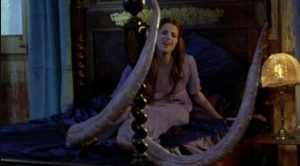
Pacing and Storytelling
“Dagon” unfolds at a relentless pace once Paul reaches Imboca, quickly moving from one perilous encounter to the next. This pacing contributes to a sense of urgency and escalating dread, but it can also feel overwhelming, leaving little room for character development or narrative breathing space. While this rapid pace aligns with the protagonist’s frantic fight for survival, it may make it difficult for viewers to fully connect with the characters or absorb the implications of the unfolding horror.
The film follows Lovecraftian storytelling conventions by emphasizing atmosphere and the progressive revelation of cosmic horror over character-driven arcs. This results in a plot that leans heavily on exposition, particularly through Ezequiel’s monologues, which may feel overly explanatory to some. However, these scenes are necessary to ground the audience in Lovecraft’s intricate lore, particularly for viewers unfamiliar with the source material.
The climactic moments, featuring Paul’s final confrontation with Dagon and the horrifying revelations about his heritage, deliver a suitably unsettling payoff. The ending adheres to Lovecraft’s trademark style of unresolved, nihilistic conclusions, which may leave audiences with more questions than answers. This choice, while faithful to Lovecraft’s ethos, could be polarizing for viewers who prefer more conventional narrative resoéolution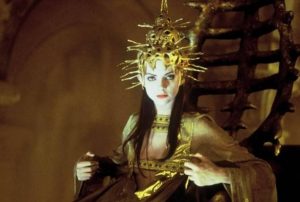
Criticism and Legacy
“Dagon” received mixed reviews upon release, with critics praising its ambition and faithfulness to Lovecraft’s themes but noting its limitations due to budget constraints and uneven pacing. The film’s modest special effects, while impressive in places, occasionally betray its low-budget origins, particularly in scenes involving CGI water or elaborate creature effects. Some viewers found the blend of practical and digital effects inconsistent, with the latter sometimes diminishing the impact of key scenes.
Despite these criticisms, Dagon has cultivated a strong cult following among fans of Lovecraftian horror. Stuart Gordon’s dedication to adapting Lovecraft’s vision, despite financial and technical limitations, has earned the film a place in the niche of horror cinema that values atmosphere and existential dread over mainstream polish. The film is often cited as one of the more faithful adaptations of Lovecraft’s work, capturing the thematic essence of his stories better than many higher-budget productions.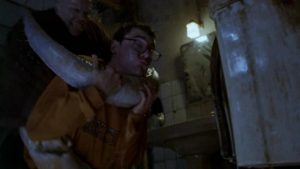
Conclusion
“Dagon” (2001) stands as a testament to Stuart Gordon’s commitment to bringing H.P. Lovecraft’s unique brand of horror to life. While it is not without its flaws—most notably, uneven special effects and rapid pacing—the film succeeds in evoking a sense of dread and cosmic horror that fans of Lovecraft will appreciate. Its exploration of themes such as the price of forbidden knowledge, humanity’s place in an indifferent universe, and the corruption of body and soul aligns closely with Lovecraft’s literary work.
Ezra Godden’s performance, the unsettling atmosphere of Imboca, and the creative practical effects contribute to the film’s eerie, claustrophobic feeling. While Dagon may not appeal to all horror fans due to its niche style and adherence to Lovecraftian tropes, it remains an essential watch for those interested in cosmic horror and adaptations that dare to preserve the existential unease central to Lovecraft’s writing.
Overall, Dagon is a flawed but effective entry into the canon of Lovecraftian cinema, offering a glimpse into a world where ancient gods reign and humanity’s fate is but a footnote in their incomprehensible schemes. For viewers seeking a horror film that prioritizes atmosphere, philosophical dread, and an unsettling narrative, Dagon delivers an experience that lingers long after the screen fades to black.











